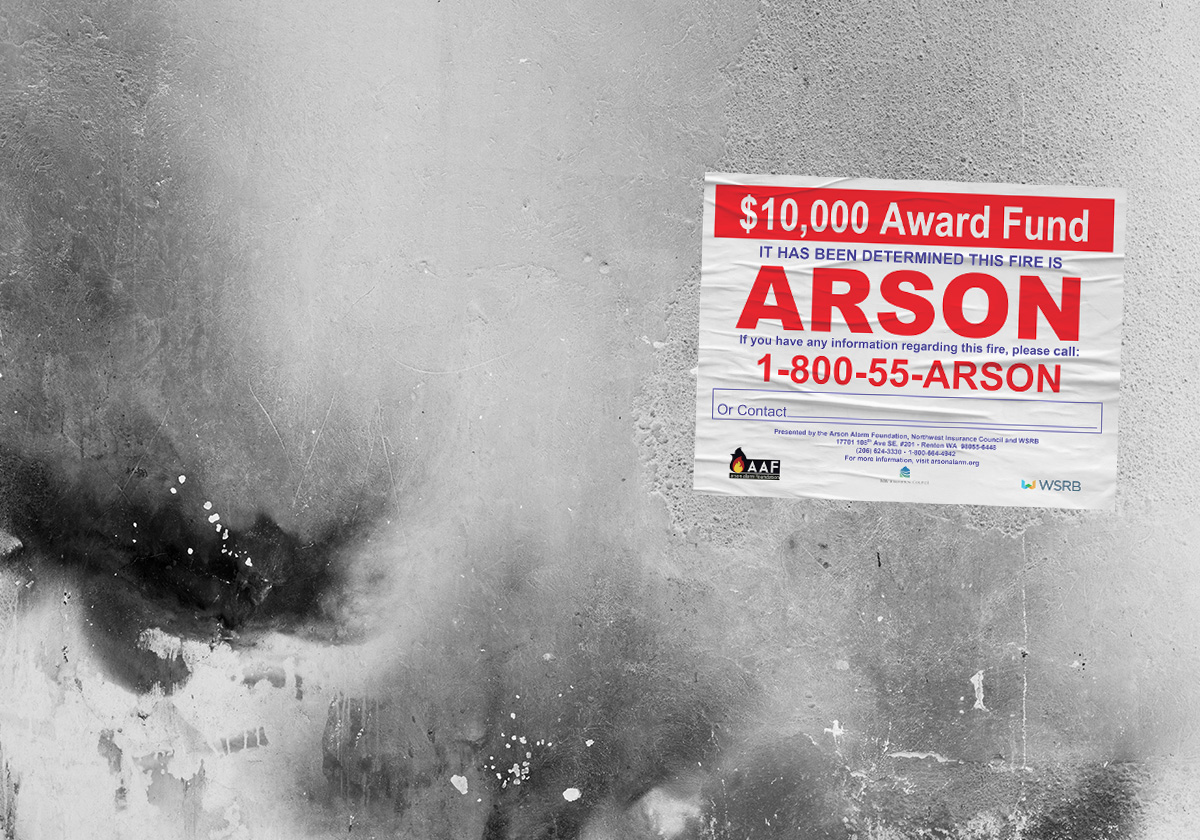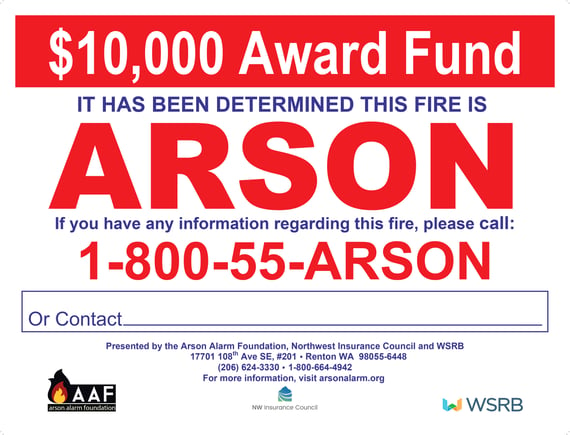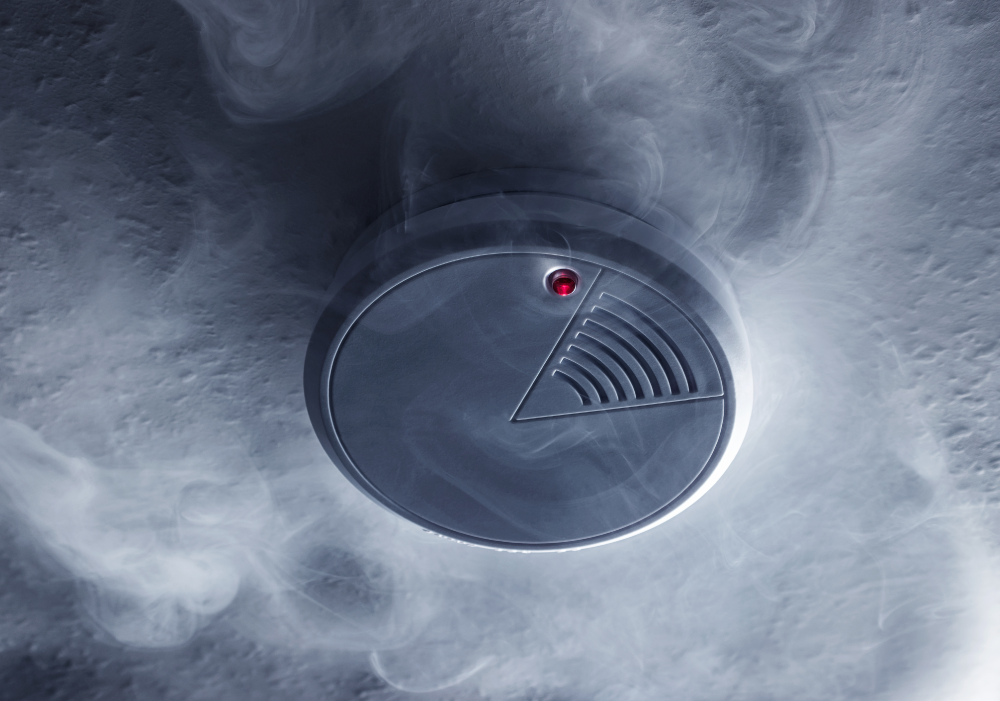It's no surprise that fire is one of the significant causes of loss in the United States. But it may come as a shock to realize that many fires are started on purpose.
WSRB is a proud partner of the Arson Alarm Foundation (AAF), a non-profit organization dedicated to reducing the incidence of arson and increasing public awareness of arson-related risks throughout communities in Washington state. Exploring the foundation's mission alongside arson statistics and prevention strategies can provide insurers with know-how crucial to minimizing losses.
The Arson Alarm Foundation
The AAF was created in 1977 through the collaborative effort of insurance industry representatives, the Seattle Fire Department, the National Fire Protection Association (NFPA), and other agencies, including:
- NW Insurance Council
- International Association of Arson Investigators
- National Association of State Fire Marshals
- U.S. Fire Administration
- Washington Association of Sheriffs & Police Chiefs
Their stated goals are (1) to reduce loss by arson through public awareness, advertising, and communication, (2) to promote social science research through statistical and behavioral analysis, and (3) to encourage coordinated efforts between private and public agencies through cooperation and generalization.
The AAF maintains a $10,000 annual award fund and operates a toll-free arson hotline (1-800-55-ARSON) for tips regarding arson fires in Washington.
To find out more or download printable posters in English or Spanish about the hotline and reward, visit the Arson Alarm Foundation website here.
National arson statistics
A core element of the AAF's mission is educating insurance professionals. Exploring arson facts and statistics can help you understand this risk and experience fewer losses.
According to estimates by the National Fire Protection Association (NFPA) for 2014-2018, about 52,260 intentional fires were reported annually, resulting in roughly 400 civilian deaths, 950 civilian injuries, and $815 million in direct property damage each year.1 This average is close to the 14-year average of 54,500 between 2004-2018.
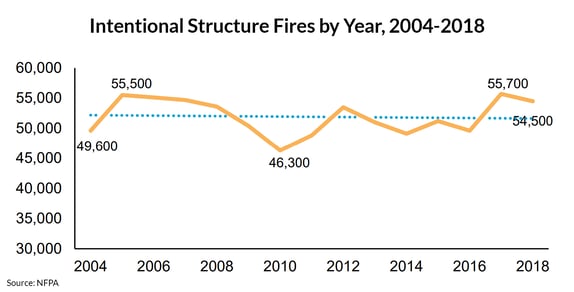
Intentional structure fires account for a sizable percentage of all structure fires, civilian deaths, civilian injuries, and direct property damage.
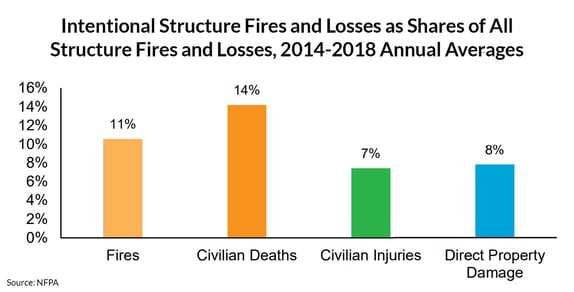
The National Fire Incident Reporting System (NFIRS) defines intentional fires as those triggered by deliberately misusing heat sources or other incendiary devices. Under this definition, not all intentional fires are considered arson; an act of arson involves the criminal intent to cause harm. In Washington and other states, harm can include the intent to collect insurance proceeds.2
What kind of people commit arson?
Arsonists are disproportionately male, and most are on the younger side. 44% of people arrested for arson in 2014 were under 21, and 34% of all arrestees were under 18. Children under a certain age cannot be charged with arson in some jurisdictions.1
In many cases, multiple fires are set by the same person. Someone suspected of multiple offenses will commonly be charged for incidents with the most substantial evidence. Many officials consider a case of arson “cleared” if they’re satisfied they’ve identified the fire-setter, even if no arrest was made.
Some buildings are more arson-prone than others.
Contrary to popular opinion, fire-setters don’t always target empty buildings.
Three of every five intentionally set structure fires occurred in residential properties. Another fifth of intentional structure fires occur at what the NFPA classifies as "outside or special properties," namely mailboxes, bridges, and tunnels. Smaller shares of intentional structure fires occur in storage facilities, mercantile/business structures, assembly properties, and educational properties.
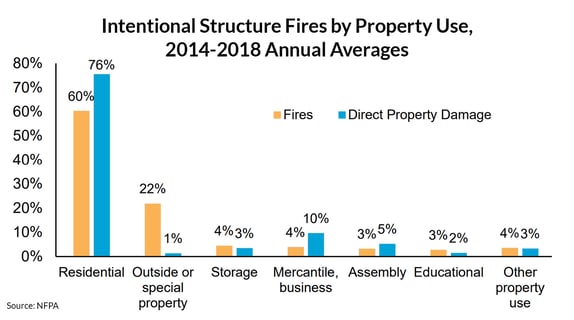
The cost of arson
The FBI reported in 2019 that the average cost of damages caused by arson was $16,371.2 However, this figure only scratches the surface of the full story. Damages to structures, as opposed to vehicles or other property types, averaged $29,568. Single-family homes, on average, incurred damages of $30,308, while non-industrial commercial properties experienced an average of $36,402 in damages. In contrast, industrial and manufacturing buildings sustained the most significant costs, with an average of $190,336 in damages.
Tips to protect against arson
While it takes a community to prevent intentional fires and arson, here are some recommendations for property owners, courtesy of FEMA and the U.S. Fire Administration:
- Install lights on all sides of a given structure, including motion-activated lighting near the entrances and timers in the interior to give the illusion the building is occupied.
- Install smoke alarms and a fire sprinkler system, which can protect against loss from any fire, including intentionally set ones.
- Clear obstructions that block the view of the building from the street, keeping bushes and shrubbery trimmed.
- Keep doors and windows locked, using deadbolts on external doors and spring-loaded window bolts attached to the wall frame.
- Keep the area around your building clean. Paper trash, partially full cans of paint, and other debris can become kindling or fuel for an arsonist.
- Secure vacant buildings with additional locks and boarded-up windows. Consider disconnecting gas utilities and removing oil tanks.
- Through Nextdoor or Neighborhood Watch programs, encourage neighbors to watch for suspicious activity and write down potential suspect descriptions and license plates.
Conclusion
The Arson Alarm Foundation operates in Washington state, teaching and providing the public with resources to prevent and report instances of arson. Insurers must educate themselves and their customers to minimize future losses. We hope that what we've outlined in this piece gives you a basic understanding of the risks, their prevalence, and steps to avoid them.
There's no way to prevent arson entirely. As long as people with ill intentions exist, fires will start, and lives and property will be lost. However, organizations like AAF are working round the clock to do what they can and make our communities safer places to live; we are grateful and humbled to be able to work alongside them.
Want to learn more about arson in Washington? Check out our blog on the subject.
[1] NFPA, https://www.nfpa.org/News-and-Research/Data-research-and-tools/US-Fire-Problem/Intentional-fires
[2] FBI, https://ucr.fbi.gov/crime-in-the-u.s/2019/crime-in-the-u.s.-2019/tables/arson-table-2.xls
[3] FEMA, https://www.usfa.fema.gov/prevention/arson/index.html




